De novo design of potent and selective mimics of IL-2 and IL-15
- PMID: 30626941
- PMCID: PMC6521699
- DOI: 10.1038/s41586-018-0830-7
De novo design of potent and selective mimics of IL-2 and IL-15
Abstract
We describe a de novo computational approach for designing proteins that recapitulate the binding sites of natural cytokines, but are otherwise unrelated in topology or amino acid sequence. We use this strategy to design mimics of the central immune cytokine interleukin-2 (IL-2) that bind to the IL-2 receptor βγc heterodimer (IL-2Rβγc) but have no binding site for IL-2Rα (also called CD25) or IL-15Rα (also known as CD215). The designs are hyper-stable, bind human and mouse IL-2Rβγc with higher affinity than the natural cytokines, and elicit downstream cell signalling independently of IL-2Rα and IL-15Rα. Crystal structures of the optimized design neoleukin-2/15 (Neo-2/15), both alone and in complex with IL-2Rβγc, are very similar to the designed model. Neo-2/15 has superior therapeutic activity to IL-2 in mouse models of melanoma and colon cancer, with reduced toxicity and undetectable immunogenicity. Our strategy for building hyper-stable de novo mimetics could be applied generally to signalling proteins, enabling the creation of superior therapeutic candidates.
Figures












Comment in
-
Designer protein delivers signal of choice.Nature. 2019 Jan;565(7738):165-166. doi: 10.1038/d41586-018-07883-z. Nature. 2019. PMID: 30626947 No abstract available.
References
-
- Akdis M et al. Interleukins, from 1 to 37, and interferon-γ: receptors, functions, and roles in diseases. J. Allergy Clin. Immunol 127, 701–21.e1– 70 (2011). - PubMed
-
- Smyth MJ, Cretney E, Kershaw MH & Hayakawa Y Cytokines in cancer immunity and immunotherapy. Immunol. Rev 202, 275–293 (2004). - PubMed
-
- Lotze MT et al. In vivo administration of purified human interleukin 2. II. Half life, immunologic effects, and expansion of peripheral lymphoid cells in vivo with recombinant IL 2. J. Immunol 135, 2865–2875 (1985). - PubMed
Methods References
-
- Yodoi J et al. TCGF (IL 2)-receptor inducing factor(s). I. Regulation of IL 2 receptor on a natural killer-like cell line (YT cells). J. Immunol 134, 1623–1630 (1985). - PubMed
-
- Kuziel WA, Ju G, Grdina TA & Greene WC Unexpected effects of the IL-2 receptor alpha subunit on high affinity IL-2 receptor assembly and function detected with a mutant IL-2 analog. J. Immunol 150, 3357–3365 (1993). - PubMed
Publication types
MeSH terms
Substances
Grants and funding
LinkOut - more resources
Full Text Sources
Other Literature Sources

